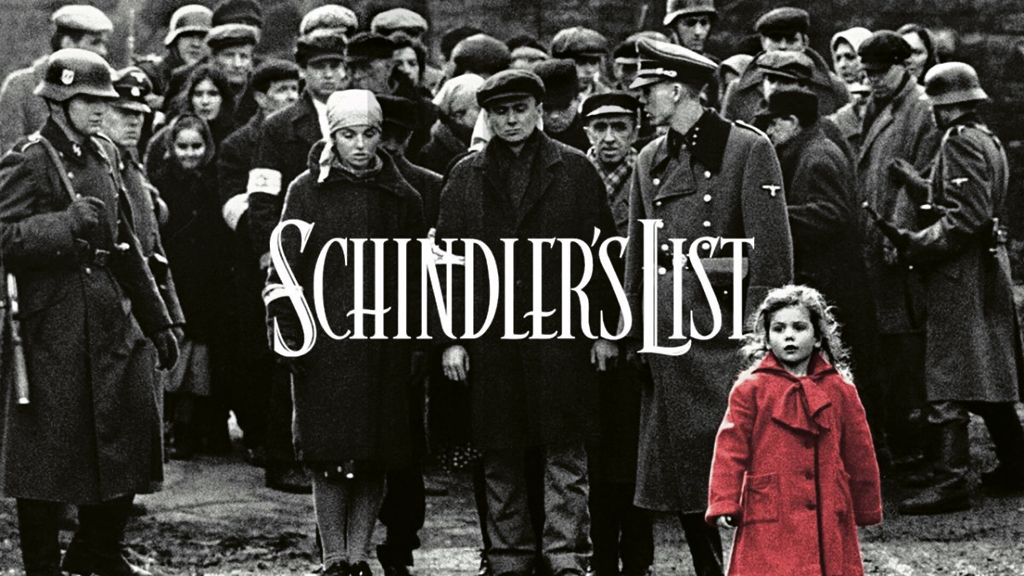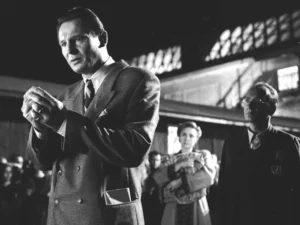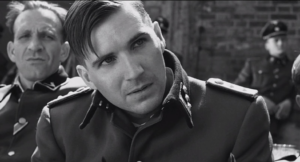
Schindler’s List (1993) – A Haunting Tale of Humanity Amidst Horror
Schindler’s List (1993), directed by Steven Spielberg, is a cinematic masterpiece that tells the true story of Oskar Schindler, a German businessman who saved the lives of over 1,100 Jews during the Holocaust. Based on Thomas Keneally’s novel Schindler’s Ark, the film stars Liam Neeson as Schindler, Ralph Fiennes as the ruthless Nazi officer Amon Göth, and Ben Kingsley as Schindler’s Jewish accountant, Itzhak Stern.
Shot in stark black and white, Schindler’s List is both a harrowing depiction of Nazi atrocities and an inspiring tale of redemption. It is a film that does not shy away from the horrors of genocide but also highlights the power of individual actions in the face of overwhelming darkness.

Plot Summary
The story begins in 1939, as Germany invades Poland. Oskar Schindler, an opportunistic businessman and member of the Nazi Party, arrives in Kraków to profit from the war. He opens a factory producing enamelware and employs Jewish workers because they are cheaper than Polish laborers. With the help of Stern, who handles the financial operations, Schindler thrives, bribing Nazi officials and living a lavish lifestyle.
However, everything changes when he witnesses the liquidation of the Kraków Ghetto in 1943. Jews are brutally murdered in the streets, families are torn apart, and those deemed unfit for labor are sent to extermination camps. Among the perpetrators is Amon Göth, a sadistic SS officer who takes pleasure in killing Jews from his balcony at the Plaszów labor camp.
Schindler, initially indifferent to the suffering around him, begins to undergo a moral transformation. Realizing the true extent of Nazi brutality, he uses his wealth and influence to protect his Jewish workers, even as it puts his own life at risk.
Schindler’s Redemption

As the war progresses, Schindler finds ways to shield his workers from deportation. He convinces Göth that his factory is essential to the war effort, ensuring that his employees are spared from execution. When the Nazis order the liquidation of Plaszów and the deportation of Jews to Auschwitz, Schindler creates the list—a document naming over 1,100 Jews whom he claims are necessary for his factory in Brünnlitz. By bribing Nazi officials, he secures their transfer, effectively saving them from certain death.
One of the most heart-wrenching moments in the film occurs when a train carrying Schindler’s female workers is mistakenly redirected to Auschwitz. Desperate, Schindler intervenes, using his fortune to negotiate their release. This act solidifies his complete transformation from a war profiteer to a savior.
The Emotional Climax
As the war ends and Germany surrenders, Schindler, now a fugitive due to his ties to the Nazi Party, prepares to flee. In a deeply emotional scene, he breaks down, realizing he could have saved more lives if he had sold his car or gold pin. His workers, grateful for all he has done, present him with a ring engraved with a Talmudic phrase: “Whoever saves one life, saves the world entire.”
The film concludes with a powerful sequence in which the real Schindler Jews, along with the actors portraying them, place stones on Schindler’s grave in Jerusalem—a traditional Jewish gesture of respect.
Themes and Symbolism

Schindler’s List explores profound themes, including the banality of evil—illustrated by the Nazi officers who kill without remorse—and the power of individual action. Schindler, an unlikely hero, demonstrates how one person can make a difference, even in the darkest times.
The film’s use of black and white enhances its documentary-like realism, making it feel like a historical record rather than a dramatization. The only color in the film appears in the iconic scene of the girl in the red coat, a haunting symbol of innocence amidst genocide. Her later appearance among the dead signifies Schindler’s turning point, as he realizes he can no longer stand idly by.
Watch Here: https://youtu.be/mxphAlJID9U?si=9v11q_TjbvSaqifZ
Performances and Impact
Liam Neeson delivers a career-defining performance, capturing Schindler’s complexity—his initial selfishness, gradual awakening, and ultimate redemption. Ralph Fiennes is chilling as Göth, portraying pure evil with unsettling realism. Ben Kingsley’s portrayal of Stern serves as the film’s moral compass, representing the silent suffering of the Jewish people.
Schindler’s List won seven Academy Awards, including Best Picture and Best Director, and remains one of the most powerful films ever made. Its impact extends beyond cinema, serving as an educational tool and a reminder of the Holocaust’s horrors.
Final Verdict: 10/10 – A Devastating, Unforgettable Masterpiece
Related Posts
-
 Matt Damon with a new look in Christopher Nolan’s new movie ‘The Odyssey’
No Comments | Apr 2, 2025
Matt Damon with a new look in Christopher Nolan’s new movie ‘The Odyssey’
No Comments | Apr 2, 2025 -
 No Country for Old Men (2007) – A Masterpiece of Fate, Violence, and Morality
No Comments | Mar 22, 2025
No Country for Old Men (2007) – A Masterpiece of Fate, Violence, and Morality
No Comments | Mar 22, 2025 -
 Tom Holland will not be returning as Spider-Man in next year’s Avengers: Doomsday! Why?
No Comments | Mar 29, 2025
Tom Holland will not be returning as Spider-Man in next year’s Avengers: Doomsday! Why?
No Comments | Mar 29, 2025 -
 How Patrick Swayze was Selected for the Role in “Dirty Dancing” Movie?
No Comments | Apr 1, 2025
How Patrick Swayze was Selected for the Role in “Dirty Dancing” Movie?
No Comments | Apr 1, 2025
